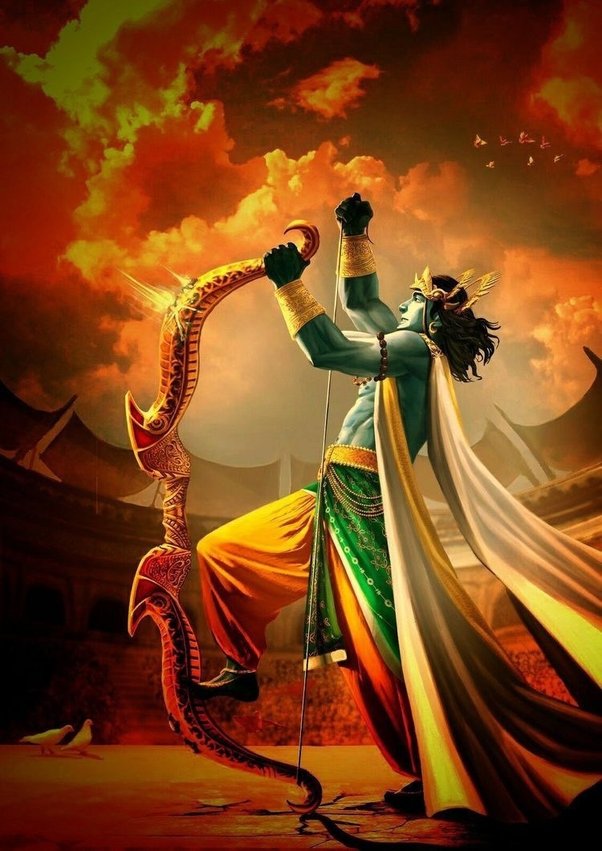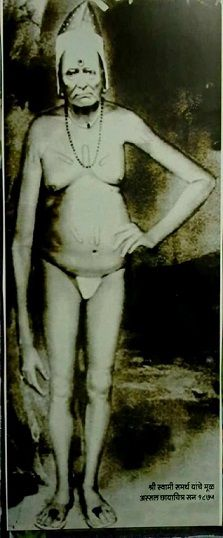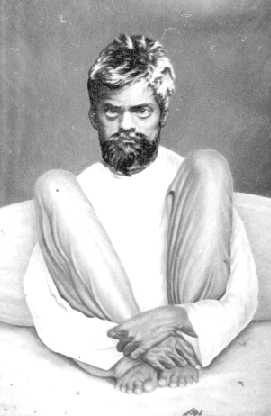Ramesh Venkataraman explores Ājānubāhu, the concept, the synonymy of the word with Sri Rāma, and explores appearance of any other Ājānubāhu persons in history.
Ājānubāhu (आजानुबाहु)

Śiva-Dhanuṣ: The great bow of Śiva
Viśvāmitra, the great BrahmaṚṣi entered the palace of King Janaka of Mithila. He walked briskly and with an air of authority that comes from having transcended the bounds of the material world. He was accompanied by two tall youngsters whose brilliant countenance seemed to dull even the fire of the Sun – they were the brothers Rāma and Lakṣmaṇā of the Kingdom of Ayodhya.
The palace guards, on seeing who the visitor was, ran ahead to let King Janaka know that the great sage was entering the palace. Janaka, who was making preparations for a great Yāga, was immensely pleased and hurried to meet and personally invite Viśvāmitra to the palace. He was accompanied by his Kula-Guru and court preceptor, Śatānanda. It was Śatānanda who first paid his respects to sage Viśvāmitra followed by King Janaka.
Viśvāmitra was not someone who beat around the bush or made small talk. He spoke to Janaka in his straightforward manner. He pointed to the two tall youngsters by his side and addressed Janaka.
“These two are the sons of Daśaratha Maharaja of the Raghu-Vaṃśa dynasty. They helped me destroy the Rākṣasas who were disturbing the Ṛṣis in their forest hermitages. They are now here to see if they would be able to take a look at the Śiva-Dhanuṣ in your possession. I would urge you to facilitate that.”
The all-knowing Janaka smiled – Janaka being a Jīvanmukta-RajaṚṣi, immediately knew the inner meaning of what sage Viśvāmitra meant. He bowed down and said,
“The princes are welcome to see the bow. As I have announced already, if this prince (pointing at Rāma) can string the bow, then I will give my daughter Sītā in marriage to him…”
Janaka then waved to his men indicating that they must bring the bow to the great hall. As the men hurried away, Janaka led the group toward the great hall where the test of strength would be enacted.
It is important to note here that Vālmīki Rāmayana describes this episode as depicted here. It is in the Rāmacaritamānasa that an elaborate Swayamvara is described with many Kings, princes and suitors failing till the time Rāma approaches the bow.
As the group waited in the great hall, the sound of wooden wheels trundling over the stone floor could be heard, the sound gradually increasing and reaching a crescendo as it neared the great hall. The great bow of Śiva was wheeled into the hall on a carriage that moved on 8 large wooden wheels. 500 men dragged it into the great hall like they would a chariot during the annual chariot festival when the Utsava-mūrtis are taken in chariots around the city. On the chariot was a large metal box with large padlocks. The men opened the locks and gently pushed the lid back to expose the giant bow housed within the box. It became clear to those who had assembled there that the bow was not only very heavy but also very long and tall. It is fair to assume that more than the weight, it was the length that baffled and confounded the kings and princes who had attempted and failed to string the bow, thus far – some of the old illustrations of this particular episode depict how the bow is taller than the man holding it – it required someone who would need to have some special physical attributes that would make it possible to be able to hold both ends of a bow as tall as this.
In order to string this bow, it had to be lifted, placed on its end, and vertically raised to its full height, then, one knee had to be flexed slightly with the big toe close to or just about touching the lower edge of the bow. Then the other leg had to be pushed back with the hamstrings and glutes tightened in order to maintain balance and brace for the recoil that would happen when the bow was strung and then released. Then the string had to be stretched and wound over the upper end of the bow to complete the challenge. This was what Rāma was expected to achieve.
Rāma first prostrated and took the blessings of his Guru, Viśvāmitra, bowed to King Janaka and the Rāja Guru, Śatānanda, then walked up to the carriage that held the bow, circumambulated it three times and then closed his eyes and prayed to Śiva, whose bow he was going to attempt to string. Rāma then reached down and picked up the bow with an effortless ease that caused all those who had assembled there to suck in their breath and hold it within. His long arms easily reached up to hold the bow erect, the lower half supported by his toe and the upper half held effortlessly in his arm, he then picked up the string, bent the bow and passed the string over the top end of the bow – the moment he did this, the bow broke with a thunderous crack that reverberated around the palace and could be heard for several miles beyond the palace limits! Rāma had achieved what was thought to be unachievable till then.
Someone with extremely long arms would have a distinct advantage over everyone else – Rāma was an outlier in that his arms were not only sinewy and powerful; they also were long enough to reach up and hold the upper end of the bow with greater ease than anyone else – this perhaps was the single biggest reason for his success.
There are several verses and passages in the Rāmayana which point to how Rāma was specially endowed with arms that were powerful and long enough to reach up to his knees – he was an Ājānubāhu, someone “blessed” with extraordinarily long hands.
Long, strong, sinewy arms have for long been seen as a symbol of strength, protection, and justice. Sanatana Dharma takes this particular aspect forward while giving it a completely new and divine interpretation. Many of the Archa-mūrtis (idols/Vigrahas that are consecrated and worshiped) particularly of Nārāyaṇa/Viṣṇu that we see in temples depict this aspect – arms that are long and reach almost up to the knees. The Hindus have a name for it, Ājānubāhu (आजानुबाहु). जानु = knee | बाहु = arm, and therefore Ājānubāhu is he whose arms are unusually long and reach up to his knees whilst standing.
Of the great Ājānubāhus, Sri Rāma is without doubt the greatest – warrior par excellence, archer without a peer, devoted son, husband, brother, and friend, chivalrous to a fault, protector of Dharma, decimator of foes, and Puruṣottama extraordinaire.
In the Dhyana shloka that appears at the beginning of the Rāma-Rakṣa-Stotra (श्रीरामरक्षास्तोत्रम्), we are asked to meditate on the form and characteristics of Rāma, as follows:
ध्यायेदाजानुबाहुं धृतशरधनुषं बद्धपद्मासनस्थं
Let’s meditate on that long-armed form with arms reaching up to his knees, carrying the great bow and with its inexhaustible quiver of arrows, he who is seated in lotus pose
Before we move on to a few more instances where reference is made to Sri Rāma’s Ājānubāhu stature, another important aspect connected to Rāma’s feat of stringing the bow needs to be examined.
Bowstrings during ancient times were made of twisted rawhide, gut, or sinew. Hemp and silk came much later and today they have largely been replaced by dacron, polymers, and polyethylene – the bow Rāma strung most likely had a bowstring made from twisted rawhide. It must have required phenomenal strength and flexibility to stretch it to that length. Also, remember that the bow had not been in use for a long time, which meant it must have hardened as well, making it extremely difficult to bend the bow and pass the string over it. While it was the normal practice to string the bow just before use in order not to destroy the tensile strength of the wood, not using a bow for a long time was also not advisable. The ancient bows were made of natural wood, unlike the fiberglass or carbon fiber material that is in vogue nowadays. The fact that it had not been in use for a long time, could also be a reason why it snapped when it was bent beyond its limit of tensile tolerance.
In the Bālakanda, of the Rāmayana, Nārada while describing Sri Rāma’s physical form to Vālmiki, refers to him as Ājānubāhu:
महोरस्को महेष्वासो गूढजत्रुररिन्दमः|
आजानुबाहुः सुशिराः सुललाटः सुविक्रमः|| १-१-१०
Mahā-uraskaḥ = he whose chest is broad, leonine, and magnificent; Maheśvāsaḥ = wielder of the great bow of Śiva (Dhanuṣ); Gūdhajatruḥ = he who is thick-shouldered, with powerful, bunched muscles that conceal the collarbones under their thick mass; Arimdamaḥ = the subjugator of his foes and those who are adharmis; Ājānubāhuḥ = he whose powerful arms reach up to his knees, Suśirāḥ = head that is held high and clear of the shoulders, sitting on top of a conch-shaped neck; Sulalāṭaḥ = an ample, forehead that is free of lines and clear; Suvikramaḥ = he whose gait is as majestic and powerful as that of a lion.
“Sri Rāma is handsome, with a broad leonine chest, brilliantly formed, sculpted, and muscular shoulders, with the bunched muscles hiding the collar bones. He holds his head high like the emperor he is. His arms are long, strong, sinewy, and reach up to his knees and he carries that great bow of Maheśa (Śiva) with which he subdues all enemies of Dharma. His forehead is broad and clear with no wrinkles or worry lines, and his gait is as magnificent as the lion”
When Hanumān makes the great leap across the ocean and finally locates Sītā in Rāvaṇa’s Lanka, she is initially skeptical about who he is and his real intentions, therefore she tests him with some questions and then asks him to describe Rāma to her. Although he does not exactly use the word, Ājānubāhuḥ, he does mention Mahābāhuḥ – long-armed and powerful. This episode appears in the Sundara Kāṇḍa of the Rāmayana.
विपुल अंसो महाबाहुः कम्बु ग्रीवः शुभ आननः|
गूढ जत्रुः सुताम्र अक्षो रामो देवि जनैः श्रुतः|| ५-३५-१५
Vipulāmsaḥ = he who is broad-shouldered; Mahābāhuḥ = powerful and long-armed; Kambugrīvaḥ = with a neck that is beautifully shaped like a conch; Śubhānanaḥ = with a pleasing, pleasant, and auspicious countenance; Gūdhajatruḥ = he who is thick-shouldered, with powerful, bunched muscles that conceal the collarbones under their thick mass; Sutāmrakśaḥ = possessing beautifully shaped red-tinged eyes; Rāmaḥ = Rāma; Devi = Sītā Devi; Janaiḥ = people; Śrutaḥ = he is spoken of or these characteristics are heard (about him);
Rāma is powerfully built, broad-shouldered, with long sinewy arms. His neck is long and beautifully shaped like a conch and crowned by his magnificent head. His face radiates peace, nobility, auspiciousness, and strength, while his bunched and heavily muscled shoulders hide the contours of his collar bone, Rāma is spoken of and described thus by the people, Devi!
When Rāma and Lakṣmaṇā reach the region of Kiṣkindhā which corresponds to present-day Hampi and adjoining Anegundi, Sugrīva first spots the brothers and describes them to Hanumān as follows
दीर्घ बाहू विशालाक्षौ शर चाप असि धारिणौ|
कस्य न स्यात् भयम् दृष्ट्वा हि एतौ सुर सुत उपमौ|| ४-२-२०
Dīrgha Bāhū Vishālalākshau = Powerfully long arms, beautifully wide and clear-eyes; Śara Chāpa Asi Dhāriṇau = they seem to be expert wielders of the arrow, bow, and sword; Kasya-na-Syāt Bhayam = they scare me and frankly, tell me who would not be afraid of such beings?; Dṛṣṭvā-etau = on seeing, these two; Sura Suta Upamau = Sons of the Suras (Devas), these twins…
“Bearing long, powerful arms, eyes broad and wide, carrying their weapons, bows, arrows, and swords, these warriors scare me. Tell me Hanuman, who wouldn’t be scared looking at these twins who appear to me as divine sons of the Suras (Devas)?”
So, was Sri Rāma the only Ājānubāhu that we know of, or are there a few more in documented history? A simple internet search threw up a couple of recorded personalities from our country, both revered saints and both belonging to the Nath Parampara! Shri Swami Samarth also known as Akkalkot Maharaj, who lived in the 1850s. He was considered an incarnation of Dattatreya.

It is said, that Shri Swami Samarth, just before taking samadhi, advised his disciples to worship the Sai Baba of Shirdi because he (Swami Samarth) would henceforth reside in Shirdi A picture of Swami Samarth sourced from the internet does show that he indeed was an Ājānubāhu with his hands reaching up to his knees. Although there is no way to confirm the veracity of the image, an examination of his other images even while sitting, does show that he did possess extraordinarily long arms.
Swami Samarth’s disciple, the maverick and often misunderstood, Yogiraj Sri Shankar Maharaj is without doubt an Ājānubāhu as almost all images of him on the internet confirm this – most images show him sitting with his knees pulled up to his chest and his extremely long arms wrapped around them.

It is clear from the references scattered across the Rāmayana that Sri Rāma was specially endowed with attributes across the physical, intellectual, emotional, and spiritual dimensions of his being. While his muscular frame, powerful shoulders, and leonine chest stand out, his long, powerful, sinewy arms that reached his knees were a unique feature that made him stand out as the true Puruṣottama – an avatāra of Viṣṇu, come to establish Dharma. These physical features made him a warrior par excellence and this is perhaps why, Sri Kṛṣṇa who was a later avatāra, identified himself with Sri Rāma when it came to undefeatable and unparalleled warriors:
पवन: पवतामस्मि राम: शस्त्रभृतामहम्|
झषाणां मकरश्चास्मि स्रोतसामस्मि जाह्नवी ||BG: 10-31||
pavanaḥ pavatām asmi rāmaḥ śhastra-bhṛitām aham
jhaṣhāṇāṁ makaraśh chāsmi srotasām asmi jāhnavī
Pavanaḥ—the wind/air; pavatām—of all that purifies; asmi—I am; Rāmaḥ—I am Rāma; śhastra-bhṛitām—of the wielders of weapons & warriors of repute; aham—I am; Jhaṣhāṇām—of all aquatic animals; Makaraḥ—crocodile; cha—also; asmi—I am; Srotasām—of the flowing rivers; asmi—I am; Jāhnavī—the Ganga.
Amongst purifiers, I am the wind, amongst wielders of weapons and warriors of repute, I identify myself with Sri Rāma. Of the aquatic/water creatures, I am the crocodile, and of flowing rivers, I am the Ganga.
We could end this piece with a reference to a personality from world history who too was perhaps an Ājānubāhu – Artaxeres-I, the fifth King of Kings of the Achaemenid Empire, and the third son of the great Persian King, Xerxes who was called “Longimanus” and “Makrókheir” by the Greeks – he who possessed unusually long arms, in fact, the Greeks note that his right arm was longer than his left. He ruled from 465 to 424 BCE. He was a feared wrestler and almost unbeatable in hand-to-hand combat.

Leave a Reply